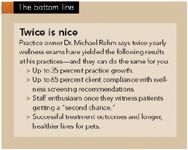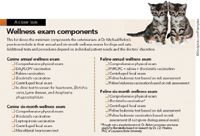Promoting twice-yearly wellness exams
This preventive care program increases client bonding and extends pets' lives.
AS CO-OWNER OF FOUR VETERINARY hospitals in Mobile, Ala., I've seen our practices experience 20 percent to 35 percent growth during the last five years. Much of this growth has resulted from semi-annual exams, which strengthen clients' bond to our practice and increase their trust in our doctors' recommendations. With more client education opportunities, compliance has soared.
Much discussion is taking place in the profession right now about the benefits of twice-yearly exams, and I know some of my colleagues are still struggling with whether to make the leap. If you're one of them, I can say without hesitation that semi-annual exams will pay big dividends for your patients and practice if you're willing to make the commitment.

Think twice about wellness
The American Dental Association and our family dentists have educated us for years about the importance of twice-yearly cleanings. We don't question our dentists—we just do it. The same can happen with veterinary clients.
Since we increased exam frequency in my practices, we've had more opportunities to educate clients about products and services to help their pets live longer, healthier lives. Educated clients are more compliant. And frequent visits allow us to better understand individual patients' health status. Twice-yearly exams have proved to be a solid foundation for high-quality healthcare programs.
Get started
First educate your healthcare team, then educate clients. A full-scale approach is best when you're transitioning to twice-yearly exams, and it's a great opportunity to overhaul your team training program.

The bottom line: Twice is nice
• Train the team. All staff members—from part-time kennel assistants to licensed technicians—need to understand the positive impact on clients, patients, and the practice. Once you get started, generating enthusiasm for twice-yearly exams is easy—you'll soon have hundreds of examples of pets getting second chances thanks to early disease detection. Making a difference in pets' lives is a tremendous staff motivator.
But first you'll need to do some up-front training. Team members are eager to learn and improve their skills. Learning is fun. Teaching is fun. And both build team spirit and increase employee retention. Start slow with your training—if you try to do too much too fast, you'll dilute your message and lose focus. Appoint a coordinator, perhaps an experienced technician, to spearhead the training initiative. Once you get started, make team training an ongoing effort. Weekly training sessions work well.
Take roll during your training sessions: Everyone must attend—no exceptions. Close your clinic so you have everyone's undivided attention. Let clients know the day and time of team training so they get accustomed to it. Set up a voice message for incoming calls saying the hospital staff is in training and will reopen at such-and-such time. Post signs on front doors and reception counters too.
For productive training sessions, get input from associates and team members. At my practices, we plan two to three meetings in advance and provide notebooks and handouts. Quizzes help ensure comprehension.
• Get clients on board. Once you've educated your team, start working to get clients on board. Plant the seed regarding twice-yearly wellness exams during a client's annual visit. Let the pet owner know he or she will receive a reminder in six months about the pet's semi-annual wellness exam. Then get your healthcare team to reinforce that message.
Decide what to include
Our doctors organized wellness protocols using our vaccination protocol and guidelines from the Companion Animal Parasite Council, which recommend twice-yearly intestinal parasite screens and monthly deworming. We then created a checklist for an annual and a six-month wellness exam (see "Wellness Exam Components"). We add additional diagnostics and wellness services based on patients' individual needs. Recommendations in areas such as dental care, nutrition, and behavior are included in all our wellness exams as well.

A closer look: Wellness exam components
Your doctors and team members can create wellness protocols based on your patients' needs, lifestyle, and environment. Ask yourself, "What components of a wellness program will maximize patient health and bring pet owners into my practice?"
Build on the foundation
Once you have an underpinning of strong wellness protocols, take preventive medicine to the next level by adding annual wellness screens. At my practices, we offer three levels of screening based on age:
- Less than 2 years old: Six-test CBC plus urinalysis.
- 2 to 6 years old: 12-test CBC including electrolytes plus urinalysis.
- 7 years or older: 12-test CBC including electrolytes plus thyroid panel and urinalysis.
Published research shows that more than 10 percent of pets brought in for annual checkups have an underlying disease or abnormality. Although apparently normal on physical exam, these pets' illnesses would go undetected without wellness screens. Twice-yearly exams and annual screening let us detect problems early, while more treatment options are available. In my four clinics we see a slightly higher percentage; up to 14 percent of patients have underlying problems.
Casey, a 7-year-old male golden retriever, is proof that a wellness screen can save a life. When Casey got his wellness checkup, his owner accepted our recommendation for a wellness profile. Blood test results showed a slightly elevated BUN, low red blood cell count, and hypothyroidism. As I performed my physical exam, Casey's abdomen felt tight—like he might have a mass. I recommended abdominal radiography and found a large mass in the mid- to cranial abdomen. Exploratory surgery revealed a large splenic tumor that had begun to rupture and bleed. Fortunately, we were able to remove the spleen without incident. Casey is one of many patients enjoying a second chance thanks to twice-yearly wellness exams and diagnostics.
Again, your team's support is key to recommending wellness screening. The first time a blood test helps you detect a problem and save a pet's life, it's an awesome feeling. Other cases will soon follow. Team members will come to believe in the benefits, and they'll share their experiences with pet owners with sincerity and conviction. When they give this advice from the heart, clients will readily accept your program. And you can use handouts such as "What Is a Wellness Screen?" to reinforce your team's message.

Information from your veterinarian: What is a wellness screen?
If you have in-house lab equipment and trained technicians, clients can get wellness screen results during appointments. You'll also run more tests with the convenience of in-house equipment. Here's a look at what you can see:
- CBCs. Several years ago, our clinics sent all CBCs to a reference lab, averaging 40 to 50 tests per month. We calculated that we'd need to run 15 CBCs per month to break even with in-house equipment. The first month we did 81 CBCs, the second month we did 120, and we haven't looked back since. Clients comply more readily when they get immediate results. Greater compliance means more medications and therapeutic diets are dispensed and further diagnostics scheduled.
- ACTH stimulation tests. Before in-house testing, we sent these tests to Auburn University with a five- to seven-day turnaround for results. Now we run ACTH stimulation tests in house with a two-hour turnaround. This has resulted in a fivefold increase in ACTH stimulation tests. With rapid results, we're also able to make a diagnosis and start pets on appropriate therapy before they leave the hospital.
- Bile acids. We now can run a liver function test in-house. Having this capability is a huge advantage for practitioners managing difficult critical cases. The more knowledge a veterinarian has about the patient's condition and internal organ function, the better he or she can successfully manage the case. Often you're working against the clock, and rapid results can mean the difference between life and death.
- Long-term medications. We also build therapeutic monitoring into our wellness structure. While our patients safely take certain drugs every day, these drugs are metabolized and excreted by the body in various ways. Changes in weight, organ function, and metabolism are critical to the therapeutic effectiveness of particular products. Our therapeutic monitoring includes checking blood levels for subtherapeutic, therapeutic, and toxic drug levels, as well as checking organ function, electrolytes, and minerals, and, if indicated, performing a CBC. Drugs such as NSAIDs, phenobarbital, potassium bromide, and digoxin especially call for regular therapeutic monitoring.
We put bright-orange stickers on patients' medical records to indicate that the pet is on a drug that needs to be monitored. We also use an orange highlighter to mark the medication in the medical record. These orange highlights and stickers remind us that clients need to be educated about the importance of periodic monitoring. We talk with clients, provide a medication monitoring brochure, and enter reminders in our veterinary software.
Address breed dispositions
Genetic predisposition is another area to consider for wellness programs. During staff training, discuss common problems with popular breeds. Clients will appreciate learning about potential problems—they'll want to know what to look for, especially if early intervention will make a difference in their pet's quality of life. Screening cocker spaniels and basset hounds for glaucoma as part of wellness checkups is a good example. Another would be ECG, chest radiographs, and cardiac ultrasound for boxers and Doberman pinschers to screen for dilated cardiomyopathy. Run a report in your veterinary software to identify the top breeds you see in your practice and develop breed-specific protocols.
Revitalize your reminders
The health of your practice depends on following up with clients when they need to bring their pets in for vaccinations, six-month exams, professional dental cleanings, thyroid checks, and any needed medical service. Five years ago we replaced reminder postcards with a voice messaging system that lets us "call" up to 1,500 clients per day. The message uses my voice or that of a team member for a personal touch, and we save $500 a month in postage alone. Besides reducing costs, we're mass communicating with clients about our products and services.
Voice messaging is not labor intensive. My office manager spends five minutes exporting data from 10,000 clients, and I record a message in 20 seconds. The system does the rest.
When we send out a voice message this way, our phones start ringing immediately. We alert staff so they're ready to schedule appointments and answer clients' questions. We've used our voice messaging system for public-service announcements about West Nile virus and rabies outbreaks. We can also introduce a new associate veterinarian or new product or service.
Here's an example of this system at work: One of our doctors read an article in a veterinary journal suggesting that wheat gluten may play a role in idiopathic epilepsy and that a wheat-free diet may reduce or eliminate the need for anticonvulsant medication. We called clients with pets on anticonvulsant therapy and told them about the study. We recommended a wheat-free diet we carry, and product sales skyrocketed. Pet owners expressed their appreciation for receiving this information and being able to make informed decisions about their pets' care.
As you can see, twice-yearly wellness exams—along with associated services such as wellness screening and a robust reminder program—benefit pets, clients, and clinics. Client satisfaction, retention, and referrals rise—and practice growth explodes.
Offering a handout. When clients check in for a wellness exam at one of Dr. Michael Rehm's practices, a receptionist hands them this client education form. In the exam room, a technician explains the benefits of a wellness profile and notes whether the client accepted or declined. If the client declines, the doctor discusses blood work as well. As a result of this 1-2-3 approach, these practices have seen a 65 percent compliance rate for wellness screening. To download a copy of the form, visit and click on Forms.
Dr. Michael Rehm co-owns four AAHA-accredited hospitals in Mobile, Ala. He hosts "Pet Talk," a local television show, and writes a weekly pet column in The Mobile Register. Send questions or comments to ve@advanstar.com